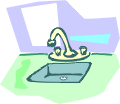 |
|
 |
|
TURBIDITY
Turbidity is a measure of the cloudiness of water- the cloudier the water, the greater the turbidity. Turbidity in water is caused by suspended matter such as clay, silt, and organic matter and by plankton and other microscopic organisms that interfere with the passage of light through the water (American Public Health Association, 1998). Turbidity is closely related to total suspended solids (TSS), but also includes plankton and other organisms.
Turbidity itself is not a major health concern, but high turbidity can interfere with disinfection and provide a medium for microbial growth. It also may indicate the presence of microbes (U.S. EPA Office of Water, Current Drinking Water Standards).
Measurement of Turbidity
 Turbidity is a measure of how much of the light traveling through water is scattered by suspended particles. The scattering of light increases with increasing suspended solid and plankton content. Turbidity in slow moving, deep waters can be measured using a device called a Secchi disk. A Secchi disk is a black and white, 20-cm diameter disk. The disk is lowered into the water until it just disappears from sight. The depth at which the disk disappears is called the Secchi depth, and is recorded in meters.
Turbidity is a measure of how much of the light traveling through water is scattered by suspended particles. The scattering of light increases with increasing suspended solid and plankton content. Turbidity in slow moving, deep waters can be measured using a device called a Secchi disk. A Secchi disk is a black and white, 20-cm diameter disk. The disk is lowered into the water until it just disappears from sight. The depth at which the disk disappears is called the Secchi depth, and is recorded in meters.
 A Secchi disk does not work in shallow, fast-moving streams. In these waters, a turbidimeter (sometimes called a nephelometer) is used. A turbidimeter measures the scattering of light, and provides a relative measure of turbidity in Nephelometric Turbidity Units (NTUs). A less expensive method of measuring turbidity is to evaluate the fuzziness of a mark at the bottom of a clear tube when a water sample is poured in the tube. Units are reported in Jackson Turbidity Units (JTUs). This method can only be used in highly turbid waters. (Mitchell and Stapp, 1992; Murdoch and Cheo, 1996)
A Secchi disk does not work in shallow, fast-moving streams. In these waters, a turbidimeter (sometimes called a nephelometer) is used. A turbidimeter measures the scattering of light, and provides a relative measure of turbidity in Nephelometric Turbidity Units (NTUs). A less expensive method of measuring turbidity is to evaluate the fuzziness of a mark at the bottom of a clear tube when a water sample is poured in the tube. Units are reported in Jackson Turbidity Units (JTUs). This method can only be used in highly turbid waters. (Mitchell and Stapp, 1992; Murdoch and Cheo, 1996)
Factors Affecting Turbidity
Because one of the primary factors affecting turbidity is toal suspended solids, the factors affecting TSS will also affect turbidity. In addition, organic matter contributes to turbidity.
High Flow Rates

The flow rate of a water body is a primary factor influencing turbidity concentrations. Fast running water can carry more particles and larger-sized sediment. Heavy rains can pick up sand, silt, clay, and organic particles from the land and carry it to surface water. A change in flow rate also can affect turbidity; if the speed or direction of the water current increases, particulate matter from bottom sediments may be resuspended (WATERSHEDSS).
 Soil Erosion
Soil Erosion

Soil erosion is caused by disturbance of a land surface. Soil erosion can be caused by Building and Road Construction, Forest Fires, Logging, and Mining. The eroded soil particles can be carried by stormwater to surface water. This will increase the turbidity of the water body.
Urban Runoff

During storm events, soil particles and debris from streets and industrial, commerical, and residential areas can be washed into streams. Because of the large amount of pavement in urban areas, natural settling areas have been removed, and sediment is carried through storm drains to creeks and rivers.
Wastewater and Septic System Effluent

The effluent from Wastewater Treatment Plants (WWTPs) can add suspended solids and organic material to a stream. The wastewater from our houses contains food residue, human waste, and other solid material that we put down our drains. Most of the solids and organic mateial are removed from the water at the WWTP before being discharged to the stream, but treatment can’t eliminate everything.
Decaying Plants and Animals
As plants and animals present in a water body die and decay, suspended organic particles are released and can contribute to turbidity.
Bottom-Feeding Fish
Bottom-feeding fish (such as carp) can stir up sediments as they remove vegetation. These sediments can contribute to turbidity.
Algal Blooms
Algal blooms can contribute to turbidity. Algal production is enhanced when nutrients are released from bottom sediments during seasonal turnovers and changes in water current. (WATERSHEDSS).
 Flooding
Flooding
As flood waters recede, they will bring along inorganic and organic particles from the land surface, and contribute this to the stream.
![]() Water Quality Standards Regarding Turbidity
Water Quality Standards Regarding Turbidity
 The U.S. Environmental Protection Agency’s (EPA) Surface Water Treatment Rule requires systems using surface water or ground water under the direct influence of surface water to (1) disinfect their water, and (2) filter their water or meet criteria for avoiding filtration so that at no time can turbidity go above 5 nephelometric turbidity units (NTUs). Systems that filter must ensure that the turbidity go no higher than 1 NTU (0.5 NTU for conventional or direct filtration) in at least 95% of the daily samples in any month. (U.S. EPA Office of Water, Current Drinking Water Standards; http://www.epa.gov/safewater/mcl.html)
The U.S. Environmental Protection Agency’s (EPA) Surface Water Treatment Rule requires systems using surface water or ground water under the direct influence of surface water to (1) disinfect their water, and (2) filter their water or meet criteria for avoiding filtration so that at no time can turbidity go above 5 nephelometric turbidity units (NTUs). Systems that filter must ensure that the turbidity go no higher than 1 NTU (0.5 NTU for conventional or direct filtration) in at least 95% of the daily samples in any month. (U.S. EPA Office of Water, Current Drinking Water Standards; http://www.epa.gov/safewater/mcl.html)